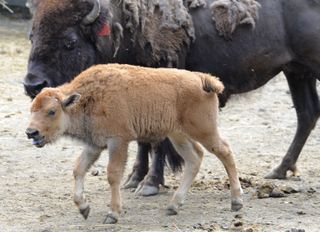Baby Bison Born Via Embryo Transfer May Boost Species Recovery

A new bison calf born this summer at the Bronx zoo is a hopeful sign for the iconic American species, which was almost hunted to extinction, but is now making a resurgence.
Very few herds of purebred bison remain in North America. Two of these herds live in Wyoming's Yellowstone National Park, but breeding them outside the park has proven difficult, until now.
On June 20 a healthy male purebred bison calf was born after its embryo was transferred from a purebred Yellowstone bison to a commercial bison at the Bronx Zoo in New York.
The transfer was carried out by researchers at Colorado State University, led by reproductive physiologist Jennifer Barfield. [Ten Species Success Stories]
"The Bronx Zoo has been working for years to secure pure bison to establish a breeding herd that could supply animals for restoration programs," Pat Thomas, vice president of the Wildlife Conservation Society and Bronx Zoo general curator and associate director, said in a statement. "Dr. Barfield and her team have provided an innovative way to rescue these valuable genes and allow us to create this important herd."
Breeding Yellowstone bison outside of the park has been difficult, because the animals there are exposed to diseases such as brucellosis, which reduces female fertility and milk production and can cause miscarriage. For that reason, the Yellowstone bison have been quarantined there and restricted from spreading to other areas.
To get around the threat of disease, the scientists extracted an embryo from a Yellowstone bison that had been exposed to disease, then washed the embryo to cleanse it of sickness, and implanted it in the uterus of a disease-free female bison.
Sign up for the Live Science daily newsletter now
Get the world’s most fascinating discoveries delivered straight to your inbox.
"In Yellowstone, the bison do not have trouble reproducing," Barfield said. "It's the process of removing animals that have been exposed to disease from the park so that their valuable genetics can be incorporated into other herds or used to create new herds that is the problem."
American bison once roamed the grasslands of North America in huge herds, but their numbers were devastated in the 19th century, when they were hunted for their hides. Bison skins were prized for use as clothing, rugs, and in factory machine belts.
This slaughter was encouraged by the U.S. government, which advocated bison hunting to free up grazing land for commercial cattle, and to thwart Plains Native Americans, who relied on the mammals for survival.
A population that started around 30 million was reduced to a few hundred by the mid-1880s.
In 1905, when the utter extinction of bison seemed imminent, Theodore Roosevelt and conservationist William Hornaday formed the American Bison Society to fight for the survival of the species. Since then, bison conservation efforts have helped the bison population recover, though not nearly to its former glory.
Follow Clara Moskowitz on Twitter @ClaraMoskowitz or LiveScience @livescience. We're also on Facebook & Google+.
Most Popular






